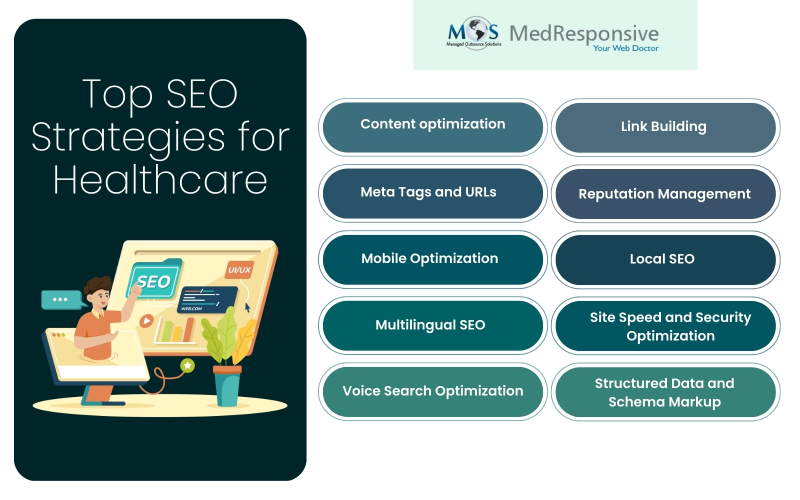When you hear the term ‘SEO’, what is it that comes to your mind first? Perhaps keyword research, analytics, and link building? Well, there’s more to it! While elements such as social media and content marketing play an important role in helping a medical website rank well, effective medical SEO today goes far beyond those basics. That said, content creation, though extremely valuable, can often be extremely time consuming and difficult to measure. This is why combining content marketing with solid strategies like onsite healthcare SEO is essential. By optimizing the on-page, off-page, and technical aspects of your blog, you create a well-rounded website optimization strategy. This positions your site to perform better in search engines, driving improved traffic, increased user engagement, stronger rankings, and ultimately, more conversions. Practices can partner with a trusted healthcare SEO agency to benefit from targeted strategies tailored specifically to the unique needs of your website.
The following practices form the foundation of an effective healthcare SEO plan:
Healthcare SEO Made Simple: Key Strategies You Can’t Ignore
Here are the healthcare SEO tips to attract more patients and expand your practice’s reach:
ON-PAGE SEO
- Content Optimization
Creating accurate and relevant medical content with materials such as blog posts, articles, and infographics is crucial to target distinct audience types and drive engagement. High-quality, keyword-optimized content strategy that addresses common patient needs, concerns, and questions clearly with reliable information can help to meet search intent. Medical content is highly scrutinized by Google’s algorithm, so showing E-E-A-T signals is essential to establish authority and credibility of your content. With informative, helpful, and well-organized website content structure, you make it easier for search engines and real people to find and trust your medical content.
- Conduct thorough healthcare-specific keyword research focused on terms that patients commonly use and include them in various strategic positions into your content to effectively reach your target audience.
- Develop clear, informative pages that answer common patient questions and avoid complex medical jargon that common readers may find difficult to understand.
- Use headings and subheadings to structure content logically.
- Regularly update content to reflect the latest medical information and guidelines.
- Include reputable, trustworthy citations and author credentials to establish credibility.
User-friendly and purposeful content not only improves search rankings but also strengthens patient confidence in your services.
- Meta Tags and URLs
Optimizing Meta titles, descriptions, and URLs enhances how your pages appear in search results, contributing to overall improved user experience of your site. Descriptive tags and clean URLs guide search engines and users, improving click-through rates, and overall site performance.
- Write concise, keyword-driven Meta titles that accurately reflect the content of each page.
- Craft compelling Meta descriptions that summarize the page content and include actionable call-to-actions to boost click-through rates.
- Keep URLs short, simple, readable, and keyword-relevant to improve both SEO and user experience.
- Avoid duplicate Meta titles and descriptions across multiple pages to avoid content cannibalization.
- Maintain consistent naming conventions across Meta tags and URLs for easier organization and long-term SEO management.
Proper Meta and URL optimization ensures smoother browsing experience, better indexing, and higher rankings for your website.
- Mobile Optimization
A significant portion of healthcare searches, over 70% to be more precise, happens on mobile devices. A mobile-friendly healthcare site is no longer optional but a necessity as Google prioritizes mobile-version for indexing and ranking purposes. In addition to having a responsive site, offering an app can make the site even more accessible to a wide audience. A website that works well on smartphones and tablets across various screen sizes can provide better user experience, resulting in reduced bounce rates, improved visibility, and increased engagement rates.
- Implement responsive design that automatically adjusts to different screen sizes.
- Optimize images and minimize page load times with minimal scripts, browser caching, and content delivery network (CDN) for faster mobile performance.
- Simplify clickable elements such as navigation menus, buttons, and links for easier use on small screens.
- Enable mobile-friendly user forms with auto fill, drop downs, and minimal required fields to improve patient interactions such as appointment bookings.
- Incorporate assistive features such as alt text for images, closed captioning, voice control support, and screen reader compatibility to provide inclusive experience and meet legal accessibility standards.
- Periodically review the mobile version of your medical site to uncover and fix user experience issues.
Mobile optimization not only increases accessibility but also promotes longer visits and better visibility.
- Multilingual SEO
Practices often provide services to communities that speak different languages. Websites can present content in multiple languages that are common with their target audience for wider reach and better access to health information. A well-executed multilingual SEO strategy for healthcare also improves user experience and SERP rankings.
- Identify commonly spoken languages in your service areas using patient data and local demographics reports.
- Perform keyword research for each language and each region as search terms vary significantly.
- Create professionally translated, dedicated pages or sections for each language instead of relying on automatic translation tools.
- Implement hreflang tags to direct search engines in displaying the right localized version for users based on their location.
- Monitor performance metrics of multilingual pages separately to refine your optimization strategy.
An effective multilingual SEO ensures that your website is accessible to a broad demographics, increasing engagement and enhancing online presence.
- Voice Search Optimization
With the rise of smart assistants such as Siri, Alexa, and Google Assistant, more patients are searching for medical information through voice commands. Optimizing for voice search ensures your practice appears when people ask conversational, question-based queries.
- Use natural, conversational language in your content to match how people speak.
- Target long-tail keywords and full-sentence questions patients might ask.
- Create FAQ sections addressing common healthcare concerns with clear, concise answers.
- Prioritize mobile optimization for your medical site, since the majority of voice searches are performed on smartphones.
Voice search optimization improves your visibility for a growing segment of searches that often indicate high intent.
OFF-PAGE SEO
- Link Building
Earning backlinks from reputable health sources act as “votes of confidence”, signaling to search engines that your content is valuable and the website is credible. In healthcare, acquiring links from recognized medical institutions, healthcare publications, and medical directories hold particular value. Building high-quality backlinks for medical websites expands your reach and authority.
- Identify reputable medical and local websites for high-quality link building opportunities.
- Develop valuable, well-researched thought leadership resources that others will naturally want to reference and link to.
- Participate in healthcare community development initiatives such as guest posting, giving interviews, engaging in medical forums to share expertise and establish credibility.
- List your practice in authoritative local and industry-specific directories for improved visibility.
- Avoid toxic backlinks especially from low-quality or spammy sites that could harm your reputation and negatively impact your rankings.
Strong backlinks improve your site’s authoritativeness and help attract more patient traffic.
- Reputation Management
Approximately 75% of patients search online to find new doctors, dentists, and other healthcare service information before choosing their provider. This is why maintaining a positive online reputation is vital for not only attracting new patients but also retaining old patients. Timely responses and consistent engagement show that you value patient feedback.
- Recommend satisfied cases to leave honest reviews and testimonials on trusted platforms through gentle reminders such as text, SMS, or at checkout to foster transparency and attract new patients.
- Monitor online reviews regularly using tools such as Google Alerts to address concerns and implement prompt corrective actions.
- Reply courteously and promptly to all feedback, be it positive or negative.
- Share and promote positive user-generated content such as stories, quotes, or testimonials on your website and social media with permission to highlight quality of care.
- Maintain consistent business information across review sites by routinely checking your listings to ensure accuracy in details such as working hours, service description, and contact number.
Effective reputation management enhances digital footprint, builds trust and persuades prospective patients to choose your services.
- Local SEO
Most patients search for healthcare clinics and hospitals near their locations, which is why optimizing for your local audience is crucial. Implementing effective local SEO strategies for doctors and clinics can help you appear prominently in search results of their geographic area. Key steps include:
- Build and fully optimize your Google Business Profile with accurate practice details, quality images, listed services, and contact details.
- Use location-based keywords in your content, metadata, and headings to target patients searching within your geographic area.
- List your practice in reputable local directories and healthcare-specific listings to increase visibility.
A strong local optimization method connects you to patients looking for your services in your community.
Technical SEO
- Site Speed and Security Optimization
Fast-loading, secure pages are essential for keeping users engaged and improving overall experience on your site. In fact, 53% of mobile users will leave a page if it takes more than three seconds to load. Slow-loading websites not only frustrate users but also affect SEO rankings, as search engines prioritize speed in their ranking algorithms. Moreover, insecure medical sites are vulnerable to cyber-attacks, which can compromise sensitive personal information and damage trust.
- Compress and resize images using modern formats to reduce file sizes.
- Minimize unnecessary scripts and plugins.
- Regularly test your site’s speed with tools such as Google PageSpeed Insights and resolve issues.
- Make sure your hosting infrastructure can handle your site’s traffic without lag.
- Implement valid SSL certificates to secure all data transfer and convert every page to HTTPS.
- Regularly update security protocols to prevent vulnerabilities and maintain compliance with privacy regulations.
Combining speed and security leads to lower bounce rates, higher conversions, and strong signals to rank your site at higher positions.
- Structured Data and Schema Markup
Adding structured data for medical websites helps search engines better understand the context of your content. This leads to enhanced appearance in rich results, knowledge panels, and local packs, making your practice more visible in online listings. For healthcare websites, schema markup can highlight critical details such as services offered, location, medical specialties, practitioner information, and patient reviews.
- Implement relevant healthcare-specific schema types such as MedicalOrganization, Physician, or Hospital to provide clear information about your practice.
- Add FAQPage schema for common patient questions to increase your chances of appearing in featured snippets and voice results.
- Use Review schema to display reviews and ratings of your practice directly in search results.
- Use structured data to display details such as address, contact information, and office hours to improve local relevance.
Properly implemented structured data not only improves online visibility but also contributes to higher click-through rates and better user engagement.
Partner with Digital Marketing Experts for SEO Excellence
Implementing the comprehensive SEO strategies given above is no longer optional but essential for medical practices in this age of digital dominance. Healthcare SEO is not just about gaining better visibility and higher rankings for your site but also making your services more accessible. As website optimization is a continuous process, healthcare providers stand to gain SEO success by partnering with experienced providers of healthcare digital marketing services. Just as a patient visit requires the combined effort of doctors, nurses, and other clinical staff for successful outcomes, medical SEO requires the collaboration of content creators, web developers, and analysts. Together, these experts ensure that your practice not only reaches the right audience but also builds trust, authority, and long-term patient relationships in the digital space.





